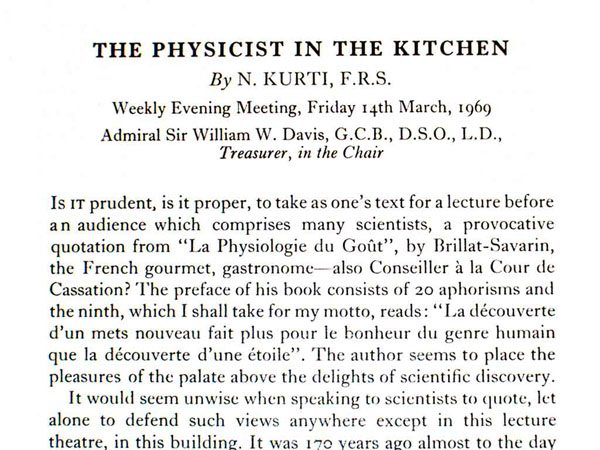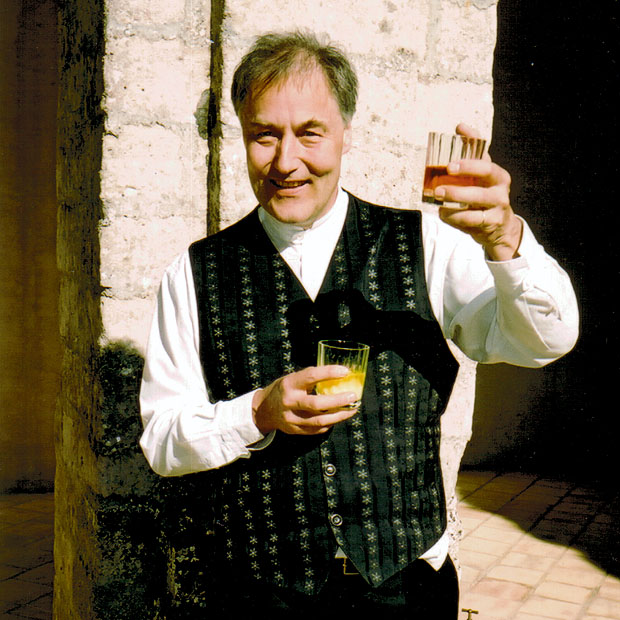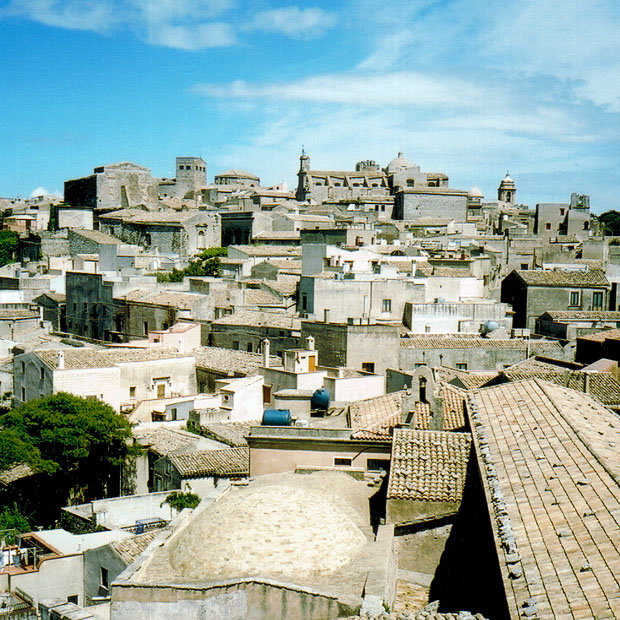In 1969, the hungarian born physicist Nicholas Kurti (1908-1998) held a presentation for the Royal Society entitled “The Physicist in the Kitchen”.

He started of by refering to one of the aphorisms in Brillat-Savarin’s book “The physiology of taste” which translates to something like:
“The invention of a new dish is of greater importance to the happiness of mankind, than the discovery of a new star”
It was also in this presentation that we find the perhaps most quoted words by Nicholas Kurti:
“I think it is a sad reflection on our civilization that while we can and do measure the temperature in the atmosphere of Venus we do not know what goes on inside our soufflés.”
In his lecture, Kurti suggest using syringes to inject rum into mince pies and to use the proteolytic enzymes in fresh ananas juice to tenderize meats. One of the recent inventions in the kitchen at the time of the presentation was the microwave oven. Kurti describes how the microwaves can be used to create an inverted baked Alaska. Baked Alaska is a dessert where a hot, baked meringue contains cold, frozen ice cream. The inverted baked Alaska, described as a Frozen Florida, consists of a container made out of meringue. The container is filled with an alcoholic liquor and put in the freezer. After a couple of hours, the container is taken from the freezer and put into a microwave oven. The result is a dessert which is hot inside, but remains cold on the outside.
Kurti also advocated low temperature cooking. It is actually not a new invention. The English scientist Benjamin Thompson described in the 18th century how a joint of meat could be left in a drying oven over night and how he was surprised when, the next morning, the meat was found to be fully cooked and very tender. Kurti repeated the experiment, leaving a 2 kg lamb joint in an oven at 80 °C. After 8.5 hours, both the inside and outside temperature of the lamb joint were around 75 °C, and the meat was tender and juicy.
Together with his wife, Giana Kurti, Nicholas Kurti edited an anthology on food and science by fellows and foreign members of the Royal Society, “But the crackling is superb”. The title stems from a television show where Nicholas Kurti demonstrated the use of ananas juice to tenderize a pork roast. A noted chef, Michel Roux, was to taste whether the ananas juice actually improved the pork roast. It turned out that after cooking, the pork roast treated with the tenderizing enzymes of anans juice was very mushy. Michel Roux of course preferred the untreated pork roast, but trying to find something nice to say, noticed that the skin was crisp and thus uttered that “the crackling is superb”.
Before I go on, I should also include a quotation by Sir Benjamin Thompson, Count Rumford, published in 1794 in his 400 page essay (entitled: “On the construction of kitchen fireplaces and kitchen utensils, together with remarks and observations relating to the various processes of cookery, and proposals for improving that most useful art”):
“The advantage that would result from an application of the late brilliant discoveries in philosophical chemistry and other branches of natural philosophy and mechanics to the improvement of the art of cookery are so evident that I cannot help flattering myself that we shall soon see some enlightened and liberal-minded person of the profession to take up the matter in earnest and give it a thoroughly scientific investigation. In what art or science could improvements be made that would more powerfully contribute to increase the comforts and enjoyments of mankind?”
This quotation is said to be one of Nicholas Kurti’s favorite quotations!
Together with the french chemist Herve This (1955-), Nicholas Kurti felt that the gap between food science and cooking at home and in restaurants was becoming to large. It was necessary to invent a new discipline. Herve This propsed “molecular gastronomy”, but Nicholas Kurti, beeing a physicist insisted that “and physical” should be added. Thus Herve This’ PhD dissertation was entitled “Molecular and physical gastronomy”. After Kurti died, the field has simply become known as molecular gastronomy.

Hervé This showing eggs immersed in colored solutions. The picture was taken at the 2004 Internationl workshop on molecular gastronomy.
The Erice workshops entitled “International workshop on molecular gastronomy” were initiated by Nicholas Kurti and Elizabeth Cawdry Thomas. The first workshop was held in 1992 and the workshop has been arange several times since then, about every second or third year. The last workshop was held in 2004. Harold McGee has written a detailed account of how the Erice workshops started and which people were involved.

Erice – a beatiful venue for the International Workshop on Molecular Gastronomy.
Herve This has written several books on molecular gastronomy, including the following: “Molecular gastronomy: Exploring the science of flavor”, “Kitchen mysteries – Revealing the science of food” and “The science of the oven”. A list of his books in French can be found here. Herve This works at the College de France, in the group for the Chemistry of molecular interactions, headed by the Nobel laurate Jean-Marie Lehn. He is one of the few scientists working full time with the subject molecular gastronomy. One of his most famous inventions is his chocolate chantilly. But according to Pierre Gagnaire, Hervé This’ main discovery is that salt coated with oil can be sprinkled on foods without dissolving, thereby retaining the “crunch”.
I you are interested in reading more, check out the comprehensive reading lists on molecular gastronomy and food chemistry. If you find molecular gastronomy intersting, chances are you will also enjoy reading about the science of everyday things.
